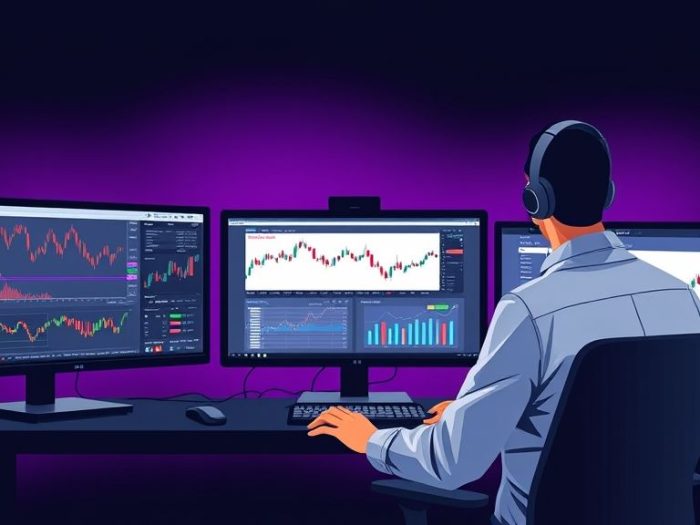A well-organized and efficient trading desk is essential for day trading success. A multiple monitor configuration can significantly enhance your ability to monitor market data, analyze charts, and execute trades quickly. This article will guide you through how to set up your day trading desk with a multiple monitor configuration, covering essential equipment, setup tips, and best practices to maximize your trading efficiency.
Why Use Multiple Monitors for Day Trading?
Day trading involves tracking numerous data points and making rapid decisions. Multiple monitors offer several advantages:
-
Increased Screen Real Estate: Allows you to view more charts, news feeds, and order entry screens simultaneously.
-
Improved Organization: Enables you to organize your trading workspace for better efficiency.
-
Faster Reaction Times: Provides a comprehensive overview of the market, allowing for quicker identification of trading opportunities and faster execution.
-
Reduced Errors: Minimizes the need to switch between windows, reducing the risk of errors.
Essential Equipment for a Day Trading Desk
Here’s a list of essential equipment for setting up a day trading desk with a multiple monitor configuration:
-
Powerful Computer: A computer with a fast processor, ample RAM, and a dedicated graphics card to handle multiple monitors and demanding trading software.
-
Multiple Monitors: High-resolution monitors (at least 1080p, ideally 1440p or 4K) with good color accuracy and refresh rates. The number of monitors will depend on your needs and budget (e.g., 2, 3, 4, or more).
-
Monitor Mounts: Sturdy monitor mounts or stands to position your monitors ergonomically and save desk space.
-
Ergonomic Chair: A comfortable and adjustable chair to support your posture during long trading sessions.
-
Fast Internet Connection: A reliable and high-speed internet connection is crucial for real-time data and order execution.
-
Uninterruptible Power Supply (UPS): A UPS provides backup power to your computer in case of a power outage, preventing data loss and potential trading disruptions.
-
Trading Software: A robust trading platform with charting tools, order entry capabilities, and Level 2 data (if needed).
Setting Up Your Multiple Monitor Configuration
Here are some tips for setting up your multiple monitor configuration:
-
Ergonomic Setup: Position your monitors at an appropriate height and distance to reduce eye strain and neck pain. The top of the monitors should be at or slightly below eye level.
-
Monitor Arrangement: Arrange your monitors in a way that suits your workflow. Common configurations include a curved arc, a straight line, or a combination of both.
-
Software Configuration: Configure your operating system and trading software to utilize the multiple monitors effectively. This involves extending your display and arranging your windows and applications across the monitors.
-
Cable Management: Organize your cables to prevent clutter and ensure a clean workspace.
Best Practices for Using Multiple Monitors in Day Trading
-
Dedicated Monitors: Assign specific monitors to specific tasks. For example, one monitor for charts, one for order entry, and one for news feeds.
-
Prioritize Information: Arrange your most important information in the center monitors for easy viewing.
-
Minimize Distractions: Use full-screen mode for your trading software and limit notifications to avoid distractions.
-
Regular Breaks: Take regular breaks to avoid eye strain and fatigue.
Conclusion
Setting up a day trading desk with a multiple monitor configuration can significantly enhance your trading efficiency and effectiveness. By investing in the right equipment, arranging your monitors ergonomically, and implementing best practices, you can create a productive trading environment that helps you stay focused, organized, and responsive to market changes. Remember to prioritize ergonomics, efficient software configuration, and minimize distractions. This information is for educational purposes only and should not be considered professional advice. Always consult with a qualified professional for personalized guidance.
Related Keywords
Day trading desk setup, multiple monitor setup, trading workstation, day trading equipment, monitor configuration, trading setup, ergonomic trading desk, best trading setup, trading computer, trading monitors.
Frequently Asked Questions (FAQ)
1. Why use multiple monitors for day trading?
Multiple monitors increase screen real estate, improve organization, allow for faster reaction times, and reduce errors by minimizing the need to switch between windows.
2. What equipment is essential for a multiple monitor day trading setup?
Essential equipment includes a powerful computer, multiple high-resolution monitors, sturdy monitor mounts, an ergonomic chair, a fast internet connection, a UPS, and robust trading software.
3. How should I arrange my monitors ergonomically?
Position monitors at an appropriate height and distance to reduce eye strain and neck pain. The top of the monitors should be at or slightly below eye level.
4. What are common monitor arrangements for day trading?
Common arrangements include a curved arc, a straight line, or a combination of both, depending on your workflow and desk space.
5. How should I configure my software for multiple monitors?
Configure your operating system and trading software to extend your display and arrange your windows and applications across the monitors for efficient multitasking.
6. How can I minimize distractions with multiple monitors?
Use full-screen mode for your trading software, limit notifications, and organize your workspace to minimize visual clutter and distractions.
7. What is the ideal number of monitors for day trading?
While at least two monitors are recommended, three or more can be ideal for optimal viewing and multitasking capabilities. The ideal number depends on your specific needs and budget.
8. What is the 20/20/20 rule?
The 20/20/20 rule suggests that every 20 minutes, you should look at something 20 feet away for 20 seconds, helping to reduce eye strain during long trading sessions.
9. How important is cable management?
Good cable management is essential for a clean, organized, and safe workspace. It prevents tangled wires and improves airflow, reducing heat buildup.
10. What are the computer requirements for a multiple monitor setup?
A computer for a multiple monitor setup should have a fast processor, ample RAM (16GB or more), SSD storage, and a mid-range graphics card with at least 4GB of video memory.



